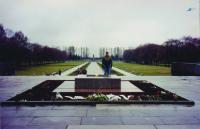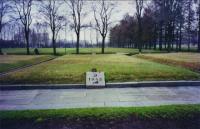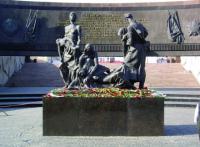
The author stands by the Eternal Flame at the Piskaryovskoye Memorial Cemetery in St. Petersburg where 500,000 are buried.

Each mound at the Piskaryovskoye Memorial Cemetery, this one for 1942, holds more than 30,000 human remains. photo by Pete Wimbrow

A view looking along the approach to the Eternal Flame and the burial mounds alongside. photo by Pete Wimbrow

Leningrad Memorial V
Seventy years ago, the Siege of Leningrad was entering its 109th week. At the outset of the war, Leningrad’s population approached 3,000,000. It was the Soviet Union’s second largest city and accounted for 10 percent of the country’s industrial output. And, of course, it was the cradle of the Communist Revolution. Today, it has reverted to its original name of St. Petersburg. When Operation Barbarossa was launched, on June 22, 1941, Leningrad was the target, 535 miles distant, of Army Group North, commanded by Field Marshal Ritter Wilhelm von Leeb.
Within the week, the Lithuanian capital, Vilnius, its second city, Kaunas, and Latvia’s second city, Daugavpils, were captured, Leningrad was bombed and Finland declared war on the U.S.S.R.
The Soviets were stunned at the speed of the German advance. City Party Boss Andrei A. Zhdanov cut short his vacation in Sochi, and returned to the city on June 27. He immediately set about preparing the city for the trials that were to come. Shelters were prepared. Sandbags were placed and 75,000 citizens were dispatched to construct defenses along the Luga River, 75 miles southwest of the city. The treasures of the Hermitage were prepared for shipment. On July 1, a great train pulled by two locomotives and consisting of an armored car for the most valuable pieces, two flatcars with antiaircraft batteries, four sleeping cars for special treasures, two passenger cars and twenty-two freight cars departed the city. It was only the first.
Army Group North had already covered 300 miles and destroyed 28 Soviet divisions. As a result, volunteers were requested to defend the city. Within a week, 160,000 had responded and on July 10, the First Division of Volunteers assembled at the train station for the trip to the front. With not enough rifles, some departed with picks, shovels, axes or hunting knives. The Second Volunteer Division arrived four days later. Untrained, they detrained straight into battle at Luga, with predictable results.
The next day, Stalin appointed his buddy, the incompetent Marshal Kliment I. Voroshilov, to command the Soviet forces defending Leningrad and facing the onrushing Army Group North. German forces were 75 miles from Leningrad. By August 8, they were 60 miles from the city. Novgorod fell on August 16 and Narva the next day. On August 26, the Estonian capital, Tallinn, was captured. However, the German Panzers were not given free rein. If they had, the German timetable of a Victory Parade on Palace Square, on July 21, might have been met. Hitler had predicted that the city would, “...fall like a leaf!”
On August 29, 1941, Viipuri, to the northwest of Leningrad, was recaptured by the Finns, as they advanced to within 30 miles of the Soviet city. Viipuri had been lost to the Soviet Union, and become Vyborg, as a result of the Winter War. At the time it was the second largest city in Finland. Before leaving the city, the Soviets destroyed most of it.
On the northern side of Lake Ladoga the Finns occupied the isthmus between Lakes Ladoga and Onega. But, the Finns would go no further. They only occupied that which had been taken from them in the Winter War. If they had launched a concerted effort, Leningrad probably would have fallen.
The city’s last rail link was cut when Mga, 30 miles to the southeast of Leningrad, was captured on August 30. German gunners found the range on September 4. The land encirclement was completed when Schluesselburg fell on September 8. The only access, now, was by air and by sea across Lake Ladoga. German troops were only nine miles from the city center, occupying suburbs where the city’s trams normally stopped. Also, that day, the Luftwaffe dropped 6000 tons of incendiary bombs on the city, destroying more than 5000 tons of precious foodstuffs. This is the day that Leningraders observe to honor those who died during the siege.
Stalin replaced Marshal Voroshilov with General Georgi K. Zhukov on September 11, who gave one order - “Attack!” And he ordered that the unit commanders lead the attacks, refusing all excuses. Six days later, Hitler began shifting troops from Army Group North to Army Group Center, for the drive to Moscow, and the German assault on Leningrad stalled. On September 16, composer Dmitri Shostakovich addressed his fellow citizens, by radio, saying, “We shall stand together and defend our city.”
On September 25, Hitler ordered Field Marshal von Leeb to cease attempts to take the city. The dictator explained that he had,
“... decided to have St. Petersburg wiped off the face of the earth. The further existence of this large city is of no interest once Soviet Russia is overthrown. The intention is to close in on the city and raze it to the ground by artillery and by continuous air attack. Requests that the city be taken over will be turned down for the problem of the survival of the population and of supplying it with food is one which cannot and should not be solved by us. In this war for existence we have no interest in keeping even part of this great city’s population.”
The great city was to be razed to the ground and conveyed to the Finns.
The first snow fell on October 14.
The city’s population had been swollen by 500,000 refugees fleeing before the onrushing Germans and 300,000 Soviet soldiers. There was very little heat. The only fuel was wood - as long as it lasted. With the onset of winter, electrical power was reduced to 15 percent of pre-war levels. Central heating ceased to exist. This, in a city, which was only ten degrees below the Arctic Circle and enduring one of the coldest winters in 150 years. Plumbing and sewage were disconnected. All factories except those of the military were closed. With no water, fires burned out of control. Food rations were cut to 1/3 of an adult’s subsistence level.
On November 20, 1941, the first few horse-drawn sleighs crossed the barely frozen Lake Ladoga. At 125 miles long and almost 80 miles wide, the Lake is the largest freshwater body in Europe. On the night of November 22, the first 60 trucks made the crossing. In the coming months many more would make the dangerous trek, braving attacks by the Luftwaffe, German artillery, the freezing cold and weak spots in the ice. The route came to be known as the “Road of Life” - Doroga Zhizni. For many of the truckers it was the “Road of Death.” Many froze in temperatures of -40 degrees F. More than 1000 trucks would be lost. But it was not nearly enough. In the last week of November, the trucks delivered 800 tons of flour - but the city was consuming 510 tons per day. At its height, the Doroga Zhizni operation involved 30,000 people and 4000 vehicles.
By the depths of that winter the daily food ration, per person, was 125 grams (4.41 oz) of bread. That is the rough equivalent of one slice of “Texas Toast,” per day. The “bread” was 60 percent sawdust. During the siege, 16,000 tons of this “delicacy” were consumed. But for many people, even that was unavailable since one had to go to the distribution center, and walking was the only means of transportation and they were too weak to walk. People tore the wallpaper off walls and ate the paste. Later, they ate the paper. Some ate the plaster. People collapsed and died in the streets and in the factories. “If this happened, there was an immediate scramble for the dead one’s ration card.” If the death occurred in the street, the body was usually left there because no one had the strength to remove it. One positive effect of the brutal cold is that it prevented the spread of disease, because the bodies quickly froze. One man remembers that no one smiled that winter or talked about food. Hospital workers took home amputated limbs. More than 2000 were arrested for cannibalism. Undoubtedly, many more escaped detection. By the end of that winter there were no pets, no birds, no mice, no rats, no insects in the city. Under these conditions, death comes in numerous ways - starvation, freezing, disease.
A citizen - Nikolai Markovich - wrote in his diary on January 24, 1942 that, “The city is dead. There is no electricity, no trams. Warm rooms are rare. No Water. Almost the only form of transport is sleds carrying corpses and plain coffins, covered with rags or half-clothed dead. Daily, six to eight thousand die. The city is dying as it has lived for the last half year - clenching its teeth.”
But Comrade Markovich wrote at the lowest point. Things slowly began to improve. With the deaths, and the evacuation of 550,000 people over the Doroga Zhizni, there were fewer mouths to feed. And the “Road of Life” was becoming more productive. Slowly, the balance was shifting to the positive. Bread rations were increased, slightly, in February.
In March, the City Council ordered the citizens to participate in cleaning the city. By April 15, 12,000 courtyards had been cleaned, 3,000,000 square yards of city streets cleared and 1,000,000 tons of filth removed. Hundreds of thousands of bodies were buried in Piskaryovskoye Memorial Cemetery. And the streetcars resumed operation. On May 16, 15,000 children were decorated for their courage. By the end of May, large scale shipments of food and materiel were being received at the newly expanded port facilities on the Lake. To boost the city’s morale, several thousand German POWs were paraded through the city on July 25. They would be the only German soldiers to reach the heart of Leningrad. Another 540,000 were evacuated by boat across the lake in the warmer months and 5000 tons of cargo was transported across the lake daily..
On August 9, 1942, the citizens, decked in their finest, attended a concert at the Philharmonic Hall to hear the premiere of the Seventh Symphony composed, during the siege, by Shostakovich, which was broadcast, by radio to the world. But the city was still under siege. During the winter of 1942-3, an additional 89,000 people were evacuated via the Doroga Zhizni.
The birth rate was 1/8 the rate prior to the siege. In 1943, 700 children were born alive. In the year before the war, 175,000 had been born.
Finally, at 9:30 A.M., January 12, 1943, 4500 Soviet guns opened fire and the Red Army attacked at Schluesselburg, from two directions. After a week of intense fighting, the two Red Armies linked and opened a narrow corridor to the city along the southern coast of Lake Ladoga. That day Zhukov became a Marshal of the Soviet Union. The Operation saw 12,000 German and 34,000 Soviet soldiers die.
Immediately, construction began on a rail line to the beleaguered city. Within twenty days it was completed and trains were delivering goods to Leningrad. With German guns only 500 yards away, only 76 trains arrived in the city in February and the line was destroyed 1200 times in 11 months. Even so, 4,500,000 tons of freight made it to the city in 1943. And the incessant shelling of the city continued.
Finally, after two weeks of an offensive by more than 1,200,000 Soviet soldiers, Stalin, on January 27, 1944, declared that the siege was lifted. At 8:00 P.M., the city celebrated with a red, white and blue salute from 324 Katyushas and artillery pieces. Less than 600,000 remained in the city.
According to the Soviets, 107,158 bombs had been dropped, and 148,478 shells fired, on the city. The siege was the costliest, in terms of casualties, in all of history.
In Piskaryovskoye Memorial Cemetery 500,000 people are buried - more dead than the United States lost in the entire war. On the wall behind the statue of Mother Russia is a poem which reads,
“Here lie Leningraders.
Here are townsfolk: men, women, children.
By their sides are Red Army Soldiers.
With their lives they defended you, Leningrad,
The cradle of the Revolution.
We cannot enumerate their noble names here;
so many are under the eternal protection of granite.
But know this, those who regard these:
No one is forgotten. Nothing is forgotten.”
On May 1, 1945 Stalin recognized Leningrad as a “Hero City.” The citizens of the city are rightfully proud of their city’s heroic endurance. Simply, they say, “Troy fell. Rome fell. Leningrad didn’t fall.”
NEXT WEEK: TROJAN HORSE
Mr. Wimbrow writes from Ocean City, Maryland, where he practices law representing those persons accused of criminal and traffic offenses, and those persons who have suffered a personal injury through no fault of their own.
«Go back to the previous page.



